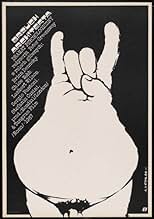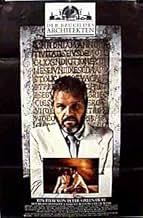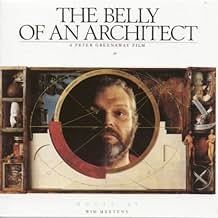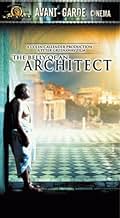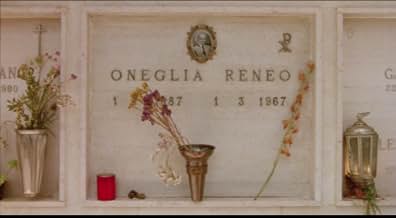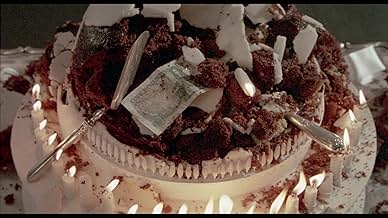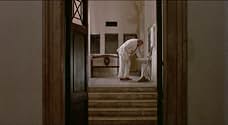AVALIAÇÃO DA IMDb
6,9/10
6,5 mil
SUA AVALIAÇÃO
Adicionar um enredo no seu idiomaAn architect supervising an exhibition starts to have mysterious stomach pains while his life slowly falls apart.An architect supervising an exhibition starts to have mysterious stomach pains while his life slowly falls apart.An architect supervising an exhibition starts to have mysterious stomach pains while his life slowly falls apart.
- Prêmios
- 2 indicações no total
Marino Masé
- Trettorio
- (as Marino Mase)
Avaliações em destaque
An American architect (Dennehy) comes to Rome with his wife to create an exhibition he's been working on for 10years. He is troubled though by a terrible pain in his stomach.
Like all Greenaway's projects, this is decidedly off kilter - though not as much as usual - with his usual structured picture framing and colour (red and green) and fabulous use of music. The wonderful soundtrack here is not by Nyman, but is very similar.
Dennehy is perfect in the lead role, but Chloe Webb as his wife puts in a rather strange stilted performance as his wife.
This starts slow but improves as it goes along as Dennehy's story unfolds. Not for everyone, but lovers of the great director will enjoy this, even if it is more orthodox than usual.
Like all Greenaway's projects, this is decidedly off kilter - though not as much as usual - with his usual structured picture framing and colour (red and green) and fabulous use of music. The wonderful soundtrack here is not by Nyman, but is very similar.
Dennehy is perfect in the lead role, but Chloe Webb as his wife puts in a rather strange stilted performance as his wife.
This starts slow but improves as it goes along as Dennehy's story unfolds. Not for everyone, but lovers of the great director will enjoy this, even if it is more orthodox than usual.
Welcome to Greenaway cinema. Having seen only his 'hit' The Cook the Thief His Wife & Her Lover(1989) and this, I cannot say much for the sum of his films. I will simply try to find and watch more film of his. His comments and quotes here in IMDb are impressive as well.
On to the film: Shot in Rome, it will thrill people with interest on architecture both visually, but thematically as well, well at least at some points. The musical score is stunning. It suits the theme and climax that Greenaway masterfully builds. As with The Cook the Thief His Wife & Her Lover, it is not various separate songs. All the soundtrack songs together form a thriumph of visual and audio art, suggesting my point about the importance of film soundtracks for an effective impact on viewer. This is a sad story, but it features some light points where joy and lust for life is celebrated - at least for my eyes and ears.
Those who criticise Greenaway for attempting only to shock the viewers have simply lost the point. Anyway. The Belly of an architect is no violent film, so it is highly recommended to those interested in films, maybe a bit 'arty', but with heart .
On to the film: Shot in Rome, it will thrill people with interest on architecture both visually, but thematically as well, well at least at some points. The musical score is stunning. It suits the theme and climax that Greenaway masterfully builds. As with The Cook the Thief His Wife & Her Lover, it is not various separate songs. All the soundtrack songs together form a thriumph of visual and audio art, suggesting my point about the importance of film soundtracks for an effective impact on viewer. This is a sad story, but it features some light points where joy and lust for life is celebrated - at least for my eyes and ears.
Those who criticise Greenaway for attempting only to shock the viewers have simply lost the point. Anyway. The Belly of an architect is no violent film, so it is highly recommended to those interested in films, maybe a bit 'arty', but with heart .
One of my favorite Greenaway films. Story, visuals, metaphor, acting, music...it's got it all. The visuals of Rome are stunning. Wim Mertens' musical accompaniment is brilliant and on par with any modern minimalist composition. After years of seeing his TV roles, I was completely floored by the depth and authenticity Brian Dennehey brought to the main character. I've watched this film at least a dozen times over the years and enjoy it thoroughly each time. Unlike a previous reviewer, I don't see the need to judge this film based on how much it resembles previous or subsequent Greenaway films. "Belly of An Architect" is not as abstract as some of the other Greenaway films, but that shouldn't be viewed as a negative. The film is great and rich in its own right. I highly recommend it.
I always know I can turn to Greenaway for nested worlds. He's one of few who can - not always mind, but the few occasions are precious - align the notions of image, how they project outwards to form what we know of reality - an empty field of anxious, random forces tossing us around - and the interior springwell from where these images flow out and which reveals ourselves to be in control of them. The play is usually given to us by some sort of fiction passing as real, or a charade within another, a story within itself, so that we may be directed from the confines of the narrow frame into a broader view that includes it.
The idea is especially powerful in the context of architecture, that we use form to project outwards a set of ideals but, having understood ourselves eventually circumscribed by structures that describe us, we can then use them to describe the inner landscape.
So indeed, we stroll around one such interior Rome, where earlier decadence or glory, or masks thereof, greeting us from marble balustrades and rows of pillars reflect inside. A city so ornately decorated and cast in stone, as though man would outlast his follies.
Into this comes an American architect - the man whose folly is to build things that last - to stage an exhibition for some obscure French architect who died 180 years ago. Italians are not too happy that he hasn't picked one of their own, but they oblige to finance nonetheless.
There are two broad ideas that Greenaway is careful to lightly caress, tease out their potential implications, but finally circumnavigate. The film would have been lesser had it settled on either, or is perhaps greater for encompassing both.
One is the doubling; the architect begins to imagine himself as his older counterpart, writing letters to him in the form of private confessional; then begins imagining himself as emperor Augustus, trapped in the same ploy of marital infidelity and murder. He replicates these stories around him. So these people overlap and are mirrored with bellies, bellies aching with the toll of creation. At this point you may think it is all going to be another film about the creative person losing himself in the mind, merging life with narrative.
The other is, as always with Greenaway, about all this as doubling for the making of the film. It's a film-within device, make no mistake. So the visionary artist is increasingly frustrated by lackeys, ignorant money-men, virulent antagonists scheming to usurp him; energy is wasted in duplicitous dinner parties and idle, but always more or less venomous, chit-chat, until eventually finds himself embittered and alone in his own set.
But it is not merely about the price of genius, or a satire of the contemporary civilized arena that it has to bleed into.
Look for the scene with his doctor in front of the busts of emperors; each bust a face and story, one decadent and evil, another perhaps famed as wise, but all inadvertently gone. A little further down is a bust without name, it could be anyone's, and whatever story will be inscribed upon it, it's again only destined to join this gallery of fiction. It is important to see these follies, but more important to see the continuity.
So it is this acceptance on the part of the architect, the man who builds things not only to last but to be beautiful in time, of the turn of the wheel, decline through rebirth. It is powerful stuff to see; the scene in the police station near the end, where he is simply asked name and age, whether married or not. He is free to go then. He has been jotted down in the ledgers.
The final scenes in the exhibition center echo with this casual dismissal of a life lived, a casual but sweet, relieving it would seem, departure after so much grief with nothing to weigh on the shoulders. He attends the exhibition, the work of a lifetime, from the balustrade above, from the vantage point of not being involved anymore. Everything looks like a small ceremony from there. So this is the nested world that matters; not the exhibition, but the creative life on the ego-redemptive journey through life at large, purging itself of itself, after the painful struggle to master the world building pantheons finally submitting to be the mastered world, transient, as it comes into being and goes again.
As he goes, new life is born down below - and plays, again and again it would seem, before the colossal marble structures.
It is perhaps the ideal Greenaway film; the self-referential tics are all present, the framework ornate, but instead of chaotic it is all mastered into a pillar that supports, unifies vision. The architect - on more levels than one - coming to terms with the architecture of a transient life.
The idea is especially powerful in the context of architecture, that we use form to project outwards a set of ideals but, having understood ourselves eventually circumscribed by structures that describe us, we can then use them to describe the inner landscape.
So indeed, we stroll around one such interior Rome, where earlier decadence or glory, or masks thereof, greeting us from marble balustrades and rows of pillars reflect inside. A city so ornately decorated and cast in stone, as though man would outlast his follies.
Into this comes an American architect - the man whose folly is to build things that last - to stage an exhibition for some obscure French architect who died 180 years ago. Italians are not too happy that he hasn't picked one of their own, but they oblige to finance nonetheless.
There are two broad ideas that Greenaway is careful to lightly caress, tease out their potential implications, but finally circumnavigate. The film would have been lesser had it settled on either, or is perhaps greater for encompassing both.
One is the doubling; the architect begins to imagine himself as his older counterpart, writing letters to him in the form of private confessional; then begins imagining himself as emperor Augustus, trapped in the same ploy of marital infidelity and murder. He replicates these stories around him. So these people overlap and are mirrored with bellies, bellies aching with the toll of creation. At this point you may think it is all going to be another film about the creative person losing himself in the mind, merging life with narrative.
The other is, as always with Greenaway, about all this as doubling for the making of the film. It's a film-within device, make no mistake. So the visionary artist is increasingly frustrated by lackeys, ignorant money-men, virulent antagonists scheming to usurp him; energy is wasted in duplicitous dinner parties and idle, but always more or less venomous, chit-chat, until eventually finds himself embittered and alone in his own set.
But it is not merely about the price of genius, or a satire of the contemporary civilized arena that it has to bleed into.
Look for the scene with his doctor in front of the busts of emperors; each bust a face and story, one decadent and evil, another perhaps famed as wise, but all inadvertently gone. A little further down is a bust without name, it could be anyone's, and whatever story will be inscribed upon it, it's again only destined to join this gallery of fiction. It is important to see these follies, but more important to see the continuity.
So it is this acceptance on the part of the architect, the man who builds things not only to last but to be beautiful in time, of the turn of the wheel, decline through rebirth. It is powerful stuff to see; the scene in the police station near the end, where he is simply asked name and age, whether married or not. He is free to go then. He has been jotted down in the ledgers.
The final scenes in the exhibition center echo with this casual dismissal of a life lived, a casual but sweet, relieving it would seem, departure after so much grief with nothing to weigh on the shoulders. He attends the exhibition, the work of a lifetime, from the balustrade above, from the vantage point of not being involved anymore. Everything looks like a small ceremony from there. So this is the nested world that matters; not the exhibition, but the creative life on the ego-redemptive journey through life at large, purging itself of itself, after the painful struggle to master the world building pantheons finally submitting to be the mastered world, transient, as it comes into being and goes again.
As he goes, new life is born down below - and plays, again and again it would seem, before the colossal marble structures.
It is perhaps the ideal Greenaway film; the self-referential tics are all present, the framework ornate, but instead of chaotic it is all mastered into a pillar that supports, unifies vision. The architect - on more levels than one - coming to terms with the architecture of a transient life.
Greenaway's visuals (which betray his origins as a painter in almost every gorgeously composed shot) are sumptuous. Wim Mertens score is mesmerizing. Add them to Brian Dennehy's towering performance as obsessed, betrayed, and ultimately dying American architect Stourley Kracklite and you have something very special. Kracklite is in Rome battling to put on an exhibition to his idol, 18th century French architect Etienne Louis Boulet. His young wife (Webb) betrays him, the natives scheme to undermine his exhibition and he begins to crumble physically like the ruins of the eternal city around him. The story, largely carried on Dennehy's massive shoulders, is almost incidental to the glorious, poetic footage of Rome. It is so movingly beautiful that, when I finally got around to visiting the city (a trip in no small part inspired by this film) the reality of the place couldn't compete. If you can, watch this on a big screen with the best possible suround-sound. If you can't, watch it anyway.
Você sabia?
- CuriosidadesBrian Dennehy was quoted after the release as saying "I've made lots of movies but only one film."
- Erros de gravaçãoWhen photocopying the picture of Augustus, Kracklite puts the picture in upside-down which would have given a blank copy. Additionally, it would not be possible to achieve the level of resolution of Augustus's abdomen from such a small picture.
- Citações
Caspasian Speckler: Your wife is very beautiful, Signor Kracklite, especially when she is pregnant.
Stourley Kracklite: Yes, that's right. She is pregnant. But not with your child, Speckler.
Caspasian Speckler: True. I'm very grateful to you for that. Your child, shall we say, is the most perfect contraceptive.
[Kracklite turns and punches Speckler in the nose]
- ConexõesFeatured in Peter Greenaway (1992)
Principais escolhas
Faça login para avaliar e ver a lista de recomendações personalizadas
- How long is The Belly of an Architect?Fornecido pela Alexa
Detalhes
- Data de lançamento
- Países de origem
- Idiomas
- Também conhecido como
- The Belly of an Architect
- Locações de filme
- Empresas de produção
- Consulte mais créditos da empresa na IMDbPro
Bilheteria
- Faturamento bruto nos EUA e Canadá
- US$ 287.725
- Tempo de duração1 hora 59 minutos
- Cor
- Mixagem de som
- Proporção
- 1.85 : 1
Contribua para esta página
Sugerir uma alteração ou adicionar conteúdo ausente

Principal brecha
By what name was A Barriga do Arquiteto (1987) officially released in India in English?
Responda

